Abstract
The influence of pH, application technique, and chlorine-to-nitrogen weight ratio on the bactericidal activity of inorganic chloramine compounds was determined with stock and environmental strains of Escherichia coli, Salmonella spp., Pseudomonas aeruginosa, Klebsiella pneumoniae, and Enterobacter cloacae. The rate of inactivation increased from 1.5 to 2 times as the chlorine-to-nitrogen weight ratio was adjusted from 2:1 to 5:1, 5 to 6 times as the pH was decreased from 8 to 6, and 5 to 6 times as the concentration was increased from 1 to 5 mg/liter. Separate additions of free chlorine and ammonia (concurrent addition and preammoniation) into seeded water at or below pH 7.5 resulted in killing comparable to that observed with free chlorine (99% inactivation in less than 20 s). At pH 8, inactivation by separate additions was considerably slower and was comparable to that by prereacted chloramine compounds (99% inactivation in 25 to 26 min). Determination of the effectiveness of inorganic chloramine compounds as primary disinfectants for drinking water must consider the method of application, pH and concentrations of chlorine and ammonia.
Full text
PDF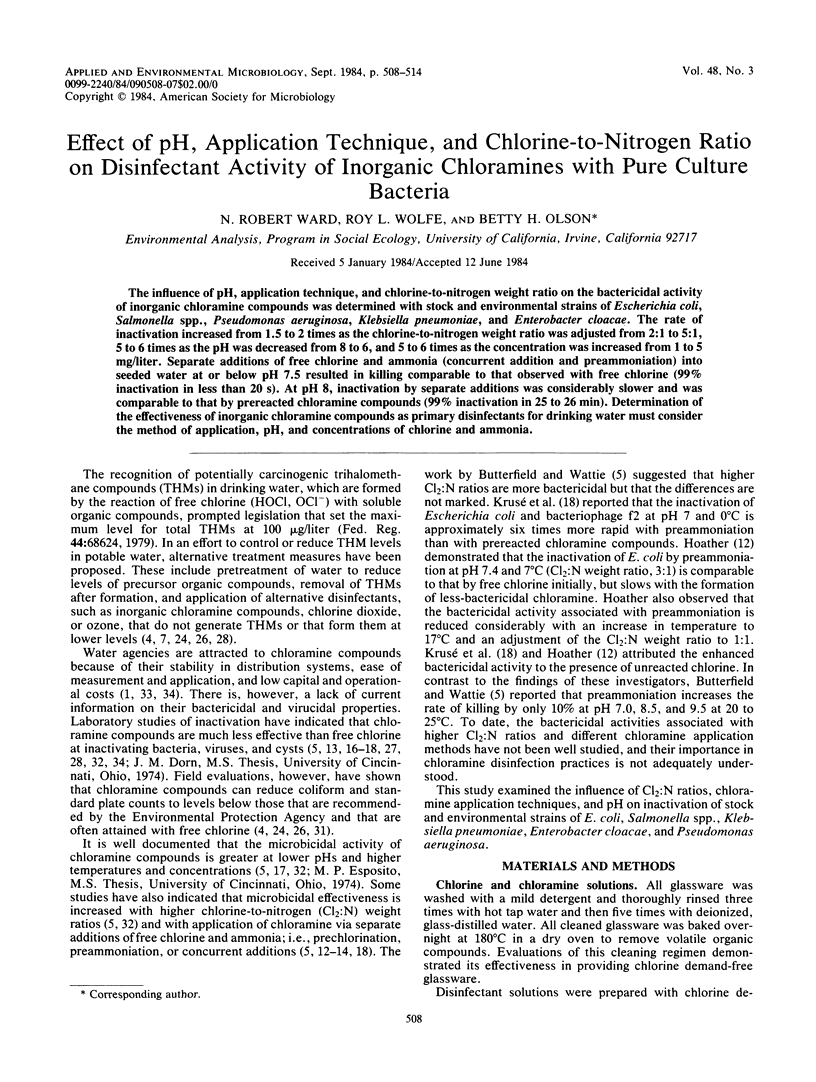
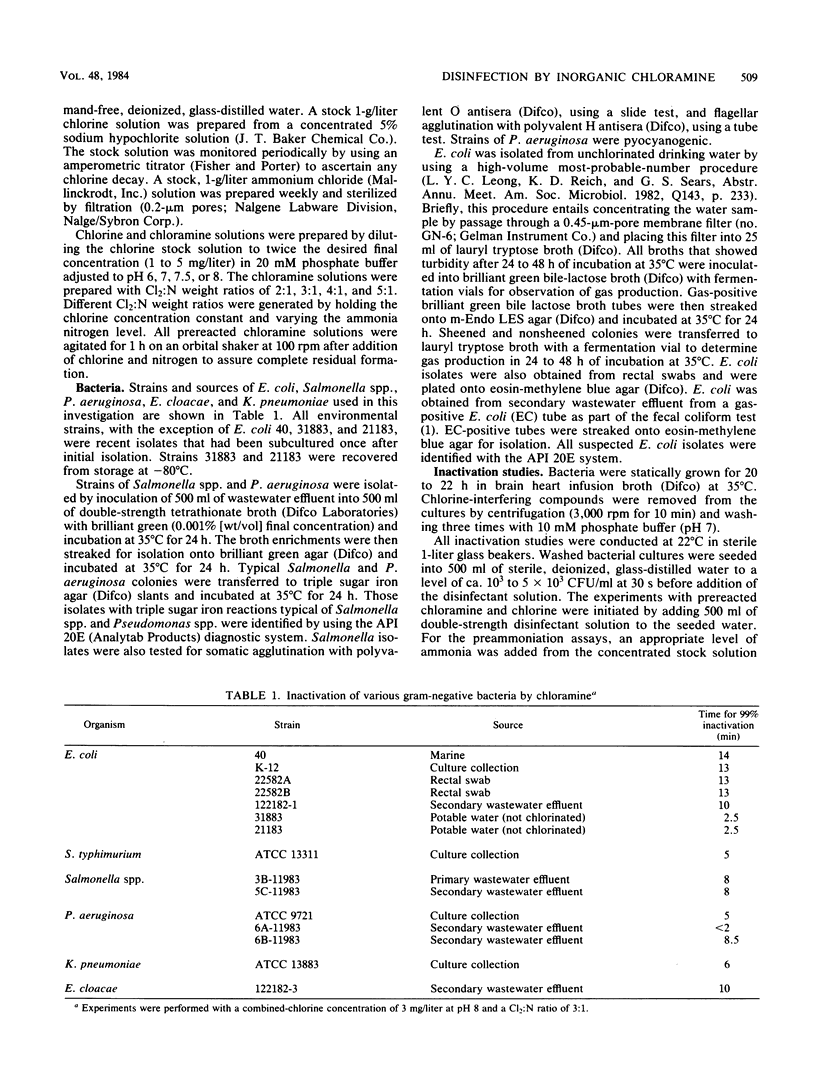
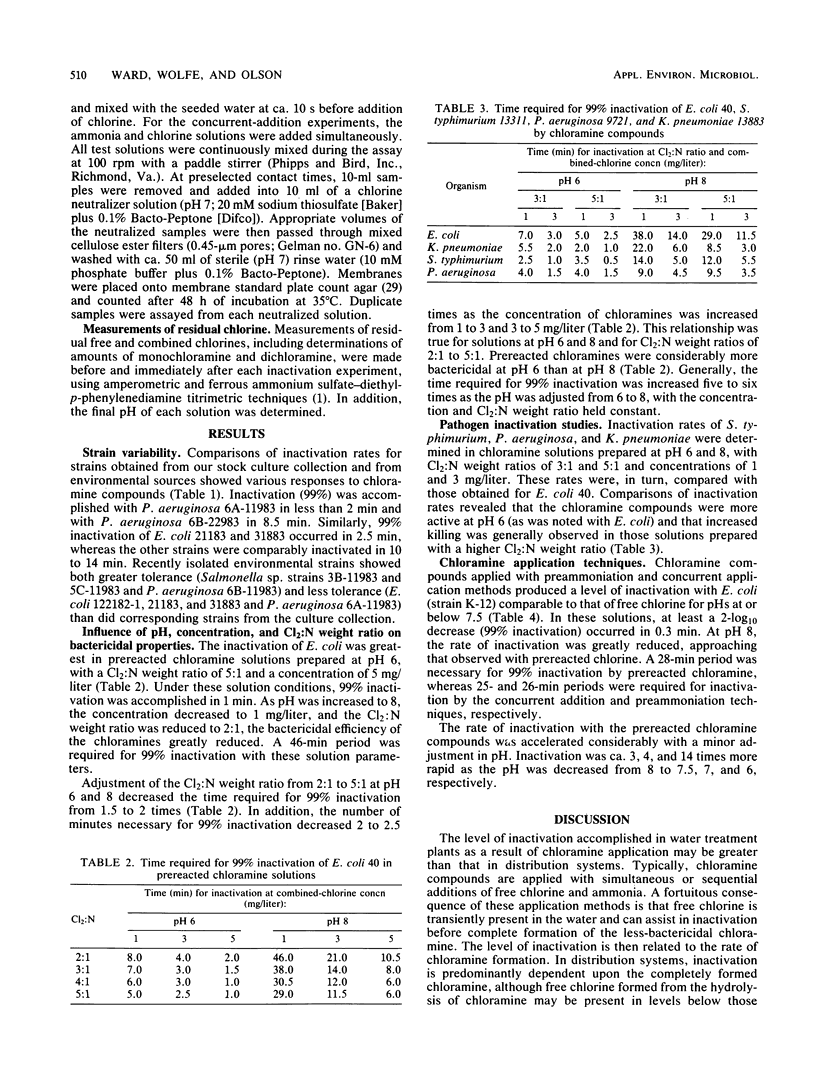
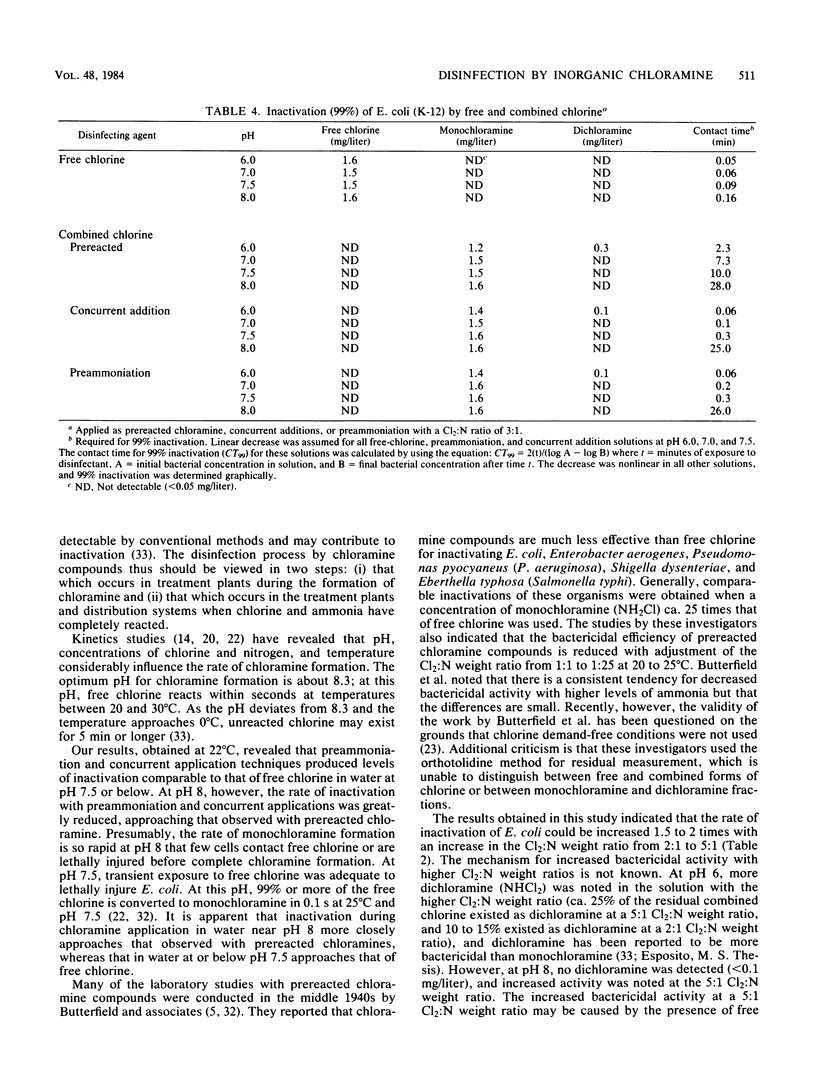
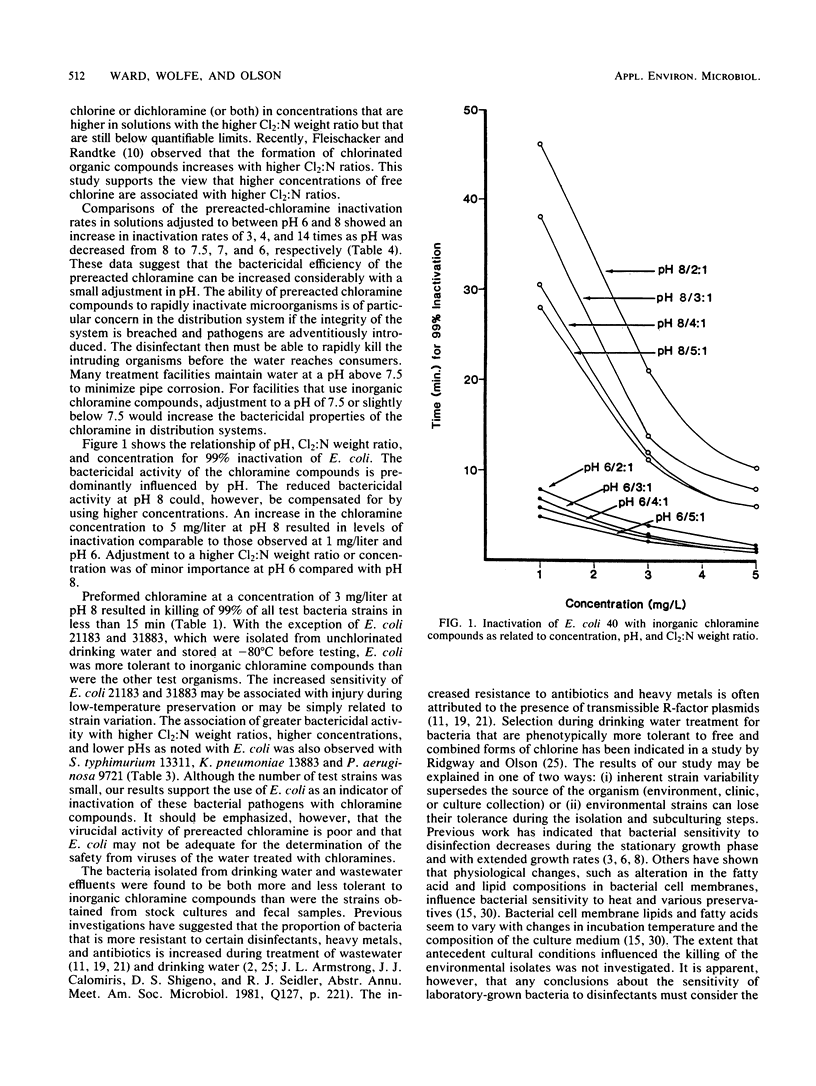
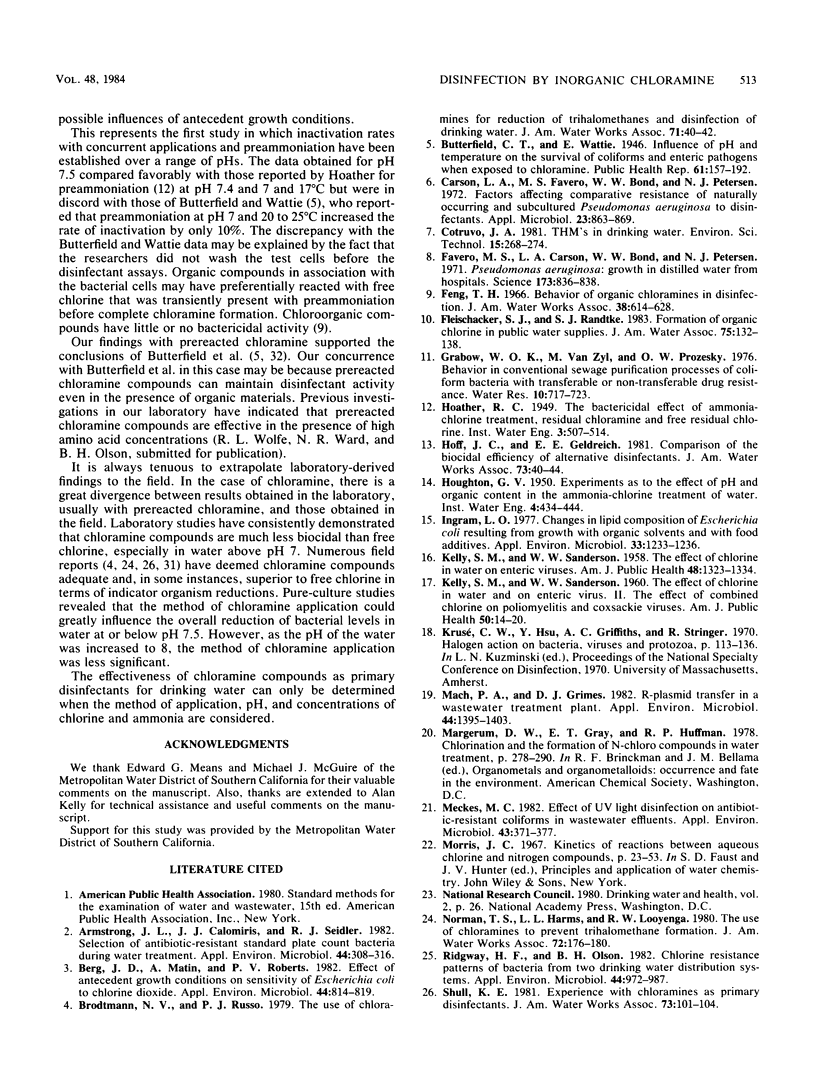

Selected References
These references are in PubMed. This may not be the complete list of references from this article.
- Armstrong J. L., Calomiris J. J., Seidler R. J. Selection of antibiotic-resistant standard plate count bacteria during water treatment. Appl Environ Microbiol. 1982 Aug;44(2):308–316. doi: 10.1128/aem.44.2.308-316.1982. [DOI] [PMC free article] [PubMed] [Google Scholar]
- Berg J. D., Matin A., Roberts P. V. Effect of antecedent growth conditions on sensitivity of Escherichia coli to chlorine dioxide. Appl Environ Microbiol. 1982 Oct;44(4):814–819. doi: 10.1128/aem.44.4.814-819.1982. [DOI] [PMC free article] [PubMed] [Google Scholar]
- Carson L. A., Favero M. S., Bond W. W., Petersen N. J. Factors affecting comparative resistance of naturally occurring and subcultured Pseudomonas aeruginosa to disinfectants. Appl Microbiol. 1972 May;23(5):863–869. doi: 10.1128/am.23.5.863-869.1972. [DOI] [PMC free article] [PubMed] [Google Scholar]
- Favero M. S., Carson L. A., Bond W. W., Petersen N. J. Pseudomonas aeruginosa: growth in distilled water from hospitals. Science. 1971 Aug 27;173(3999):836–838. doi: 10.1126/science.173.3999.836. [DOI] [PubMed] [Google Scholar]
- Ingram L. O. Changes in lipid composition of Escherichia coli resulting from growth with organic solvents and with food additives. Appl Environ Microbiol. 1977 May;33(5):1233–1236. doi: 10.1128/aem.33.5.1233-1236.1977. [DOI] [PMC free article] [PubMed] [Google Scholar]
- KELLY S. M., SANDERSON W. W. The effect of chlorine in water on enteric viruses. II. The effect of combined chlorine on poliomyelitis and Coxsackie viruses. Am J Public Health Nations Health. 1960 Jan;50:14–20. doi: 10.2105/ajph.50.1.14. [DOI] [PMC free article] [PubMed] [Google Scholar]
- KELLY S., SANDERSON W. W. The effect of chlorine in water on enteric viruses. Am J Public Health Nations Health. 1958 Oct;48(10):1323–1334. doi: 10.2105/ajph.48.10.1323. [DOI] [PMC free article] [PubMed] [Google Scholar]
- Mach P. A., Grimes D. J. R-plasmid transfer in a wastewater treatment plant. Appl Environ Microbiol. 1982 Dec;44(6):1395–1403. doi: 10.1128/aem.44.6.1395-1403.1982. [DOI] [PMC free article] [PubMed] [Google Scholar]
- Meckes M. C. Effect of UV light disinfection on antibiotic-resistant coliforms in wastewater effluents. Appl Environ Microbiol. 1982 Feb;43(2):371–377. doi: 10.1128/aem.43.2.371-377.1982. [DOI] [PMC free article] [PubMed] [Google Scholar]
- Public Health Weekly Reports for DECEMBER 29, 1944. Public Health Rep. 1944 Dec 29;59(52):1661–1692. [PMC free article] [PubMed] [Google Scholar]
- Public Health Weekly Reports for FEBRUARY 8, 1946. Public Health Rep. 1946 Feb 8;61(6):157–202. [PMC free article] [PubMed] [Google Scholar]
- Ridgway H. F., Olson B. H. Chlorine resistance patterns of bacteria from two drinking water distribution systems. Appl Environ Microbiol. 1982 Oct;44(4):972–987. doi: 10.1128/aem.44.4.972-987.1982. [DOI] [PMC free article] [PubMed] [Google Scholar]
- Tomlins R. I., Watkins T. R., Gray R. J. Membrane lipid alterations and thermal stress in Salmonella typhimurium 7136. Appl Environ Microbiol. 1982 Nov;44(5):1110–1117. doi: 10.1128/aem.44.5.1110-1117.1982. [DOI] [PMC free article] [PubMed] [Google Scholar]
- Tsuan Hua Feng Behavior of organic chloramines in disinfection. J Water Pollut Control Fed. 1966 Apr;38(4):614–628. [PubMed] [Google Scholar]


